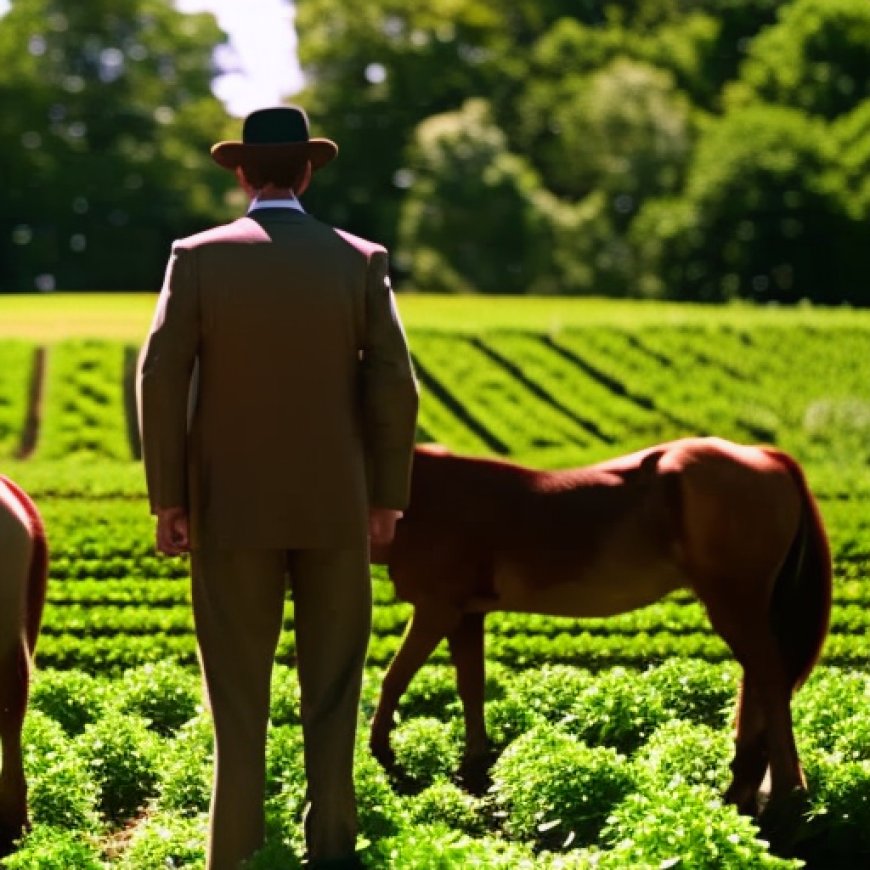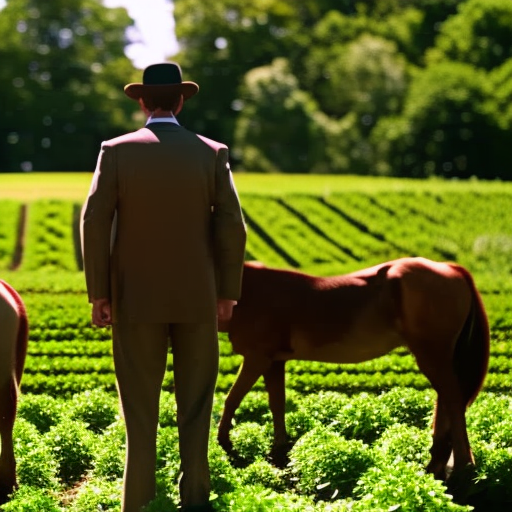Who funds regenerative agriculture?
Funding regenerative agriculture FoodNavigator.com


Improving Sustainability in the Food Industry through Regenerative Agriculture
As food industry stakeholders look for ways to improve their sustainability credentials, a number of new production methods and types have been developed, from cultivated meat to edible packaging. One of the keys to making the food industry more sustainable is addressing agriculture, which, with its links to deforestation and the environmental affects of cattle rearing, is a prominent part of the food industry’s links to climate change.
Regenerative agriculture is a key part of this. Aiming to regenerate soil and landscape rather than simply protecting it, regenerative agriculture is growing in popularity among industry.
However, as with all things new, it must make a business case for itself. Without a strong infrastructure already in place, it must build itself up to a point where it can move into the space currently taken up by traditional agriculture.
This is easier said than done. Whilst funding initiatives are in place, regenerative agriculture poses a risky proposition for many businesses.
How regenerative agriculture is being funded
On an EU level, funding is possible, especially when working in collaboration with the private sector.
For example, EIT Food, the food part of Europe’s Institute of Innovation and Technology, recently launched its regenerative innovation portfolio, aiming to help companies scale up regenerative agriculture practices through funding.
- €15m will be invested into the portfolio by EIT, matched by its corporate partners, and it will focus on five European landscapes.
- EIT will then match corporate contributions of €5m a year for three years, bringing up the total investment into the programme to €30m.
- Activities that generate a return will be invested back into the portfolio.
The money will not only be used to regenerate the landscape, but also to help participants with applications for external funding, including from government grants, public and private investment, and VC and angel investment.
Such a large initiative, which will involve many companies, could have a significant impact on regenerative agriculture. The funding will be used to upscale a range of regenerative agriculture initiatives.
“We want to move the responsibility and risk of transitioning to regenerative agricultural practices from individual farmers towards a landscape transition in which actors along the value chain collaborate and facilitate the farmer to transition to regenerative agriculture,” EIT told us.
“We need the key stakeholders in that landscape working together, including farmers, the companies that source products from that landscape, the banks that support the farmers and other actors in the supply chain.”
“To facilitate this, for every landscape a local landscape coordinator, that understands the local (business) ecosystem, dynamics and socio-cultural aspects within the region, will be appointed to engage with and orchestrate collaboration between a diverse group of stakeholders.”
The scale is a vital part of the initiative, EIT told us. Without the scale, there is no showing stakeholders that there can be a business case for regenerative agriculture; there is no showing them that it can fight food insecurity; there is no showing them that it can mitigate the effects of climate change and pollution, and improve biodiversity and soil health. Scale, in a word, matters.
Derisking regenerative agriculture
Despite significant investment from organisations such as EIT, many corporates are reluctant to stick their toe into the world of regenerative agriculture, as the business case remains uncertain. The problem of upscaling regenerative systems is a complex one, Steven Lang, managing director from the climate change investment firm Pollination, told FoodNavigator.
To persuade investors to put money into regenerative agriculture, Lang told us, he would say to them: “You’re investing in a system which is founded on robust and strengthening natural capital, which underpins all agricultural productivity; and you’re investing in the social and human capital that is the unit of production.
“I would argue that we can’t and we won’t deliver the transition to regenerative without a major central role for blended finance facilities, because the private sector is showing interest in deploying capital but it will typically say ‘we can’t find enough bankable projects, particularly in emerging markets’.”
However, investors are cautious, and must be persuaded before they put their money into risky propositions like new farming methods. This is where blended finance comes in. Blended finance is when organisations put some money into an industry or practice, such as regenerative agriculture, that could be considered risky, in order to derisk it and encourage private sector investors to provide the rest.
“There’s a massive gap,” between the private sector on the one hand, and NGOs on the other, Lang told us. “At the moment you have philanthropy ploughing its own furrow, sprinkling philanthropic dollars across lots of pilot projects; you’ve got development finance that’s doing the same, that haven’t really committed at the billion-dollar level which they really need to; and then you’ve got private sector and they’re doing their own thing in their own supply chains.”
“I would argue that we can’t and we won’t deliver the transition to regenerative without a major central role for blended finance facilities, because the private sector is showing interest in deploying capital but it will typically say ‘we can’t find enough bankable projects, particularly in emerging markets’.”
Blended finance is vital to get the private sector into a position where they feel they can invest, Lang told us. “I would argue that we can’t and we won’t deliver the transition to regenerative without a major central role for blended finance facilities, because the private sector is showing interest in deploying capital but it will typically say ‘we can’t find enough bankable projects, particularly in emerging markets’.
“They will also say that investing in some of these countries is just too risky, and it’s really difficult to get money to large numbers of smallholders. So you’ve got fragmentation risk, you’ve got country risk, you’ve got project risk; so even though there’s a wall of money building on the private sector side, it’s not yet being deployed or committed because it needs to be de-risked.
“The only way that you can really de-risk it is a major intervention from climate finance and philanthropy, with the focus of that investment also including capacity building for local institutions, strengthening farmers and organisation, basically taking away all of the layers of risk that the private sector needs to get sufficiently comfortable to participate in a blended facility.”
SDGs, Targets, and Indicators
1. Which SDGs are addressed or connected to the issues highlighted in the article?
- SDG 2: Zero Hunger
- SDG 12: Responsible Consumption and Production
- SDG 13: Climate Action
- SDG 15: Life on Land
2. What specific targets under those SDGs can be identified based on the article’s content?
- SDG 2.4: By 2030, ensure sustainable food production systems and implement resilient agricultural practices that increase productivity and production, that help maintain ecosystems, that strengthen capacity for adaptation to climate change, extreme weather, drought, flooding and other disasters, and that progressively improve land and soil quality.
- SDG 12.2: By 2030, achieve the sustainable management and efficient use of natural resources.
- SDG 13.2: Integrate climate change measures into national policies, strategies and planning.
- SDG 15.3: By 2030, combat desertification, restore degraded land and soil, including land affected by desertification, drought and floods, and strive to achieve a land degradation-neutral world.
3. Are there any indicators mentioned or implied in the article that can be used to measure progress towards the identified targets?
- Investment in regenerative agriculture initiatives
- Upskilling and training of farmers in regenerative agriculture practices
- Baseline measurements and monitoring of regenerative agriculture practices
- Increased adoption of regenerative agriculture practices by farmers
- Increased collaboration between stakeholders in the food industry value chain
Table: SDGs, Targets, and Indicators
| SDGs | Targets | Indicators |
|---|---|---|
| SDG 2: Zero Hunger | SDG 2.4: By 2030, ensure sustainable food production systems and implement resilient agricultural practices that increase productivity and production, that help maintain ecosystems, that strengthen capacity for adaptation to climate change, extreme weather, drought, flooding and other disasters, and that progressively improve land and soil quality. | – Investment in regenerative agriculture initiatives – Upskilling and training of farmers in regenerative agriculture practices – Increased adoption of regenerative agriculture practices by farmers |
| SDG 12: Responsible Consumption and Production | SDG 12.2: By 2030, achieve the sustainable management and efficient use of natural resources. | – Investment in regenerative agriculture initiatives – Upskilling and training of farmers in regenerative agriculture practices – Increased adoption of regenerative agriculture practices by farmers |
| SDG 13: Climate Action | SDG 13.2: Integrate climate change measures into national policies, strategies and planning. | – Investment in regenerative agriculture initiatives – Upskilling and training of farmers in regenerative agriculture practices – Increased adoption of regenerative agriculture practices by farmers |
| SDG 15: Life on Land | SDG 15.3: By 2030, combat desertification, restore degraded land and soil, including land affected by desertification, drought and floods, and strive to achieve a land degradation-neutral world. | – Investment in regenerative agriculture initiatives – Upskilling and training of farmers in regenerative agriculture practices – Increased adoption of regenerative agriculture practices by farmers |
Behold! This splendid article springs forth from the wellspring of knowledge, shaped by a wondrous proprietary AI technology that delved into a vast ocean of data, illuminating the path towards the Sustainable Development Goals. Remember that all rights are reserved by SDG Investors LLC, empowering us to champion progress together.
Source: foodnavigator.com

Join us, as fellow seekers of change, on a transformative journey at https://sdgtalks.ai/welcome, where you can become a member and actively contribute to shaping a brighter future.







